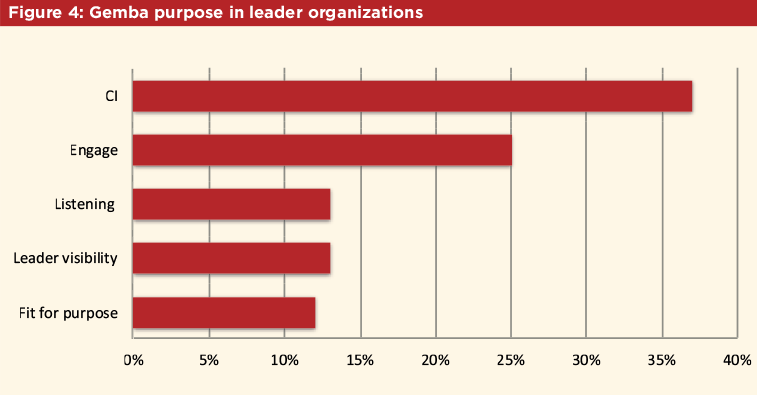How Leader Actions and Behaviors Influence Quality Culture Part 2

Shaping Excellence: How Leader Actions and Behaviors Influence Quality Culture Part 2
Quarterly Report on Quality Culture
This article was published in the November/December 2016 edition of Pharmaceutical Engineering® magazine in the Quarterly Report on Quality Culture.
On vision
To be effective, the vision is to be communicated, understood, and acted upon by every employee and external business partner, including suppliers and contractors.1 —François Sallans
The Johnson & Johnson credo4 is a renowned example of vision, as it is the foundation on which all decisions and actions regarding quality are made within the company. Another example of a strong vision is from Emergent BioSolutions: "Protect and enhance 50 million lives by 2025." This communicates the importance the company places on patient safety. A clear vision enables those in the organization to see how their roles fit into a bigger picture so they can work in alignment with the overall corporate goals. A vision that acknowledges quality also enables everyone in the organization to see its importance.
Every action we take should be aligned with and in support of our vision. If there is misalignment, we have to be willing to have the courage to challenge whether we’ve strayed from our vision or whether it is no longer relevant. Employees will see right through this, and engagement will suffer. —Allen Napetian
Vision is a critical element of leadership. It is a cornerstone, providing the foundation for the team to build upon. It’s important that vision be built in collaboration, allowing all team members to see themselves in it and understand its genesis. It is a critical element in establishing direction from which long-term strategy and planning can be constructed. —John Pinion, Ultragenyx
Best practices related to vision identified during the leader interviews include:
- Keep the vision consistent: It is detrimental to shift messages too often; it becomes confusing and unclear in the organization.
- Have the determination to ride the cycle of change. Celebrate gains, and work through the setbacks. There will always be those who are resistant to change or see no reason for it.
- Seek ways to share the vision with the organization often; the right message cannot be over communicated.
- Ensure that the vision regarding the company’s commitment to quality is readily available and can be communicated to all employees by all leaders in the organization.
Leaders must also vigilantly monitor and display key performance metrics to hold the organization accountable to its continuous improvement goals
On values
A common refrain from the interviewed leaders was the central role of integrity. Quality is often described as "doing the right thing when no one is looking"; the personal integrity of both leaders and employees is essential to achieving and maintaining a culture of excellence. Leader values or "soft skills" such as humility, empathy, and the ability to listen were thought to be highly connected to higher levels of employee engagement, a necessary enabler to a positive culture. Leaders confirmed the importance of modeling desired behaviors and "walking the talk" as it relates to quality systems and standards. This requires that day-to-day decisions be congruent with corporate values.
It’s about people. It’s how you make them feel. Are you making them feel inspired? Motivated? Full of purpose? Or are you making them feel ignored, small? You’ve got to define the mission and you’ve got to have a vision, but it’s people who give you your authority as a leader in the first place, so take care of them. —Chris Bell, Emergent BioSolutions
Courage was also commonly mentioned in leader interviews as an important value. Leaders within organizations must display the courage to make tough calls, innovate, push the envelope, challenge effectively, and break old paradigms. Leaders should also promote an environment that is open to change—where ideas that may help improve site quality are welcomed. The majority of leaders interviewed believe they have a "speak-up" culture where concerns can be raised and employees feel comfortable doing so. This is viewed as ideal for enabling cultural excellence. Many of the leaders’ companies provide anonymous call-in phone lines that allow employees to share concerns confidentially about quality or safety, for example. Some leaders, however, acknowledged that there is danger in assuming the culture is speak-up without verifying this through the employees, metrics, and results.
There’s a danger in saying "Of course everyone feels free to speak up." It becomes important for senior leaders to go out, be visible, where the work is being done. If there is a sense of seeing and hearing things for the first time, it’s probably an indication that this is not as ingrained in the culture as it should be. —Conrad Mutschler, Perrigo
On voice
You need messages that are understandable so that everyone can articulate them in his/her own words. This begins with routine and consistent cascades of communication … a source of information that is understandable and can be interpreted across different leaders and leadership styles. —Allen Napetian
When a leader articulates a vision, his/her voice and body language must be viewed by the organization as credible and trustworthy. If the leader doesn’t believe in the stated vision, however, it can have an unintended opposite effect. The leader must speak authentically to influence the desired behavior most effectively.
On vigilance
Vigilance is necessary to stay the course, put in the hard work, and endure the ups and downs of leading an organization through a journey of cultural improvement. Remaining consistent to the vision is essential. Leaders must also vigilantly monitor and display key performance metrics to hold the organization accountable to its continuous improvement goals. If you don’t measure it, you can’t improve it, so understanding the key metrics that drive quality improvement is critical. Leaders discussed their use of site scorecards, risk-assessment heat maps, and standing management overview meetings, in which quality metrics are periodically reviewed and discussed, often across various operating sites and multiple functional areas. Leading quality indicators most commonly measured at the leaders’ companies are:
- Measurements of process robustness (process capability)
- Corrective and preventive action (CAPA) effectiveness
- CAPA ratio of proactive-to-reactive actions
- Preventive maintenance
- Internal-audit findings and their risk criticality
- Total cost of quality, measured as ratio of prevention vs. remediation cost
More unique considerations for leading quality indicators include measurement of organizational learning, such as the number of green belt and yellow belt certified employees or candidates, as well as other training related and learning-based metrics. The majority of leaders interviewed believe they have a "speak-up" culture where concerns can be raised and employees feel comfortable doing so. Most leaders acknowledged, however, that they are most responsive to lagging quality indicators related to the severity of non-conformances and deviations, consumer complaints, and recalls or adverse events. Many indicated a common desire to move their organizations further toward the use of leading quality indicators, like those mentioned, for proactive review and discussion.
Know exactly what it is your organization is doing, what they’re experiencing, how they feel about the culture, and what their feedback is and let that drive some of the tactical work that you do to change culture versus taking an "off the shelf" approach … once you start down the path, continue to get feedback from people. Is this the right thing? Does it resonate with you? That’s difficult to do because it requires the leader to be a lot more visible, a lot more engaging than is comfortable to many. —Mike Vallender
You’ve got to provide timely feedback. To do that, you’ve got to be a first-class noticer (to paraphrase Warren Bennis). Pay close attention to how words and behaviors are making people feel in the context of the culture you want. Don’t let something slide more than once without giving feedback, and encourage others to do the same. —Chris Bell
Every meeting, discussion, or email is a potential opportunity to develop our leaders. If we see a behavior or an action that does not model the leadership we are pursuing, we need to take full advantage by responding. —Steve Steffes, Perrigo
Leader vigilance also involves the periodic monitoring of down-line leaders and the overall organization assessing and reassessing the state of the culture. A commonly used tool is the employee engagement survey, usually conducted every one to two years. This allows employees to share confidential feedback on the organization and leadership. Leaders suggested that conducting this survey over multiple years to see changes and improvements is of most value in "reading" for culture or cultural changes.
On visibility
Quality culture scores related to leadership (coaching, daily dialogue, and management presence on the shop floor) were also demonstrated in the "ISPE Quality Metrics Initiative: Pilot Program Wave 2 Report" as those with the highest correlation to external quality outcomes, emphasizing the importance of leader presence.2 All interviewed leaders indicated that their companies conduct some level of Gemba activity on the shop floor. The leaders themselves often participate in site walk-throughs, providing an opportunity to interact with employees, front-line supervisors, and area leaders. Gemba was most commonly viewed as a continuous
improvement (CI) tool or philosophy (Figure 4).

According to the ISPE Quality Metrics Pilot Program Wave 2 data, the highest range in quality-culture scores were from the "leadership categories" in the areas of Dialog and Gemba, as defined below:2Dialog: We have daily quality metrics reviews and quality issue discussions on the shop floor. Gemba: Management is on the floor several times a day both for planned meetings and also to observe and contribute to the daily activities. —ISPE Survey Questions: Leadership Section 2 This highlights an opportunity for industry leaders to positively affect these areas with greater leader presence and by holding other leaders accountable for reaching higher levels of visibility.
Everywhere you go, you set up listening posts like town hall meetings or roundtable meetings. You have the ability to get to know and relate to the people of the organization. —Louis Yu, Valeant Pharmaceuticals International
It became clear that employee attitudes and mindsets can be shaped by leader storytelling and quality testimonials. The leaders interviewed indicated that they hold formal and informal quality-based discussions. These are achieved formally with town hall meetings, standing management review meetings, and corporate quality updates; informal methods include employee-management roundtables, one-on-one meetings with leaders, and plant Gemba walk-throughs. These sessions provide leaders with an opportunity to talk about quality and allow employees at all levels to ask questions. Another critical element of these sessions is that they allow leaders to listen to the quality concerns, issues, and ideas raised by employees at all levels of the organization.
Conclusion
The individual leader’s actions and behaviors clearly contribute to site and company culture. Our research has shown that there are commonalities among industry leaders related to behavior, actions, and traits that can aid in employee engagement and the attainment of goals, as well as facilitate a corporate culture of excellence. For those leading and driving cultural transformation programs, key points to consider include:
- Share a vision that includes the importance of quality frequently and broadly within the organization.
- Demonstrate decision-making and behaviors that align with the stated quality vision and value excellence above sole focus on regulatory compliance.
- Shape employee experiences and mindsets through formal and informal quality discussions where site metrics are reviewed and quality issues can be raised.
- Use Gemba as a best practice activity for the shop floor, laboratories, or other functional areas. Consider Gemba guidelines or checklists to aid the walk-through.
- Develop key site metrics and implement leading quality metrics and proactive measurements to drive continuous improvement.
- Provide structural enablers to support organizational improvement and inspire an environment of continual learning.
Crucially, leaders can challenge their organizations to drive for excellence and create a culture where all benefit.
Missed part one? Catch up now - How Leader Actions and Behaviors Influence Quality Culture Want to learn more about enhancing the Quality Culture at your company? The 2017 ISPE Conference on Quality Culture and Quality Metrics will provide a collection of practical, powerful tools and a comprehensive behavior-based approach for improving quality culture as a means of delivering enhanced quality outcomes. The conference will also provide the latest data and insights for operationalization of quality metrics across the supply chain.


